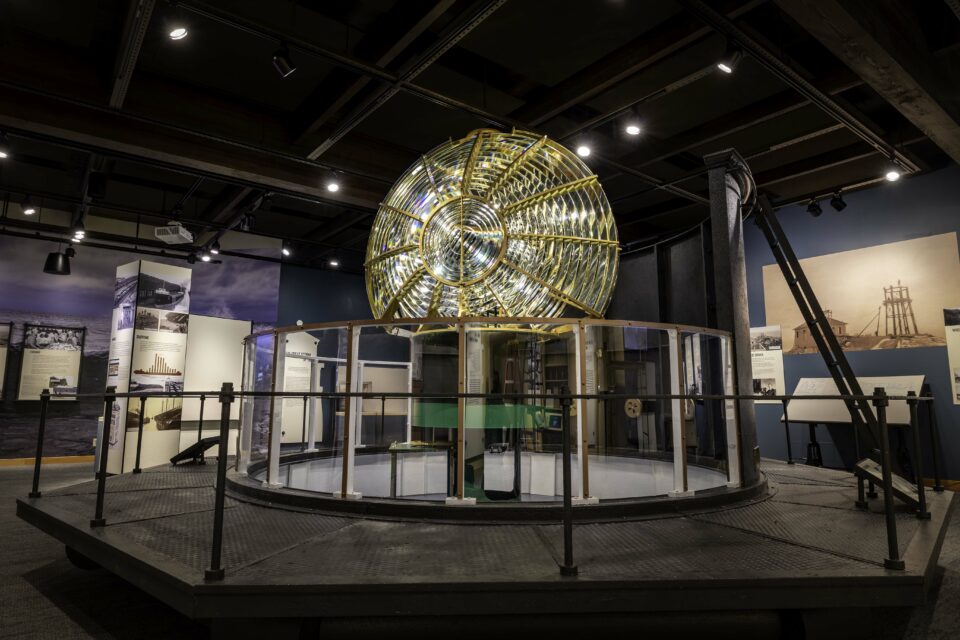The drive up the North Shore is a wonderful way to experience the scenic beauty of the area, with many amazing places to stop along the way. One of the most iconic sites to visit is the historic Split Rock Lighthouse near Two Harbors, operated by the Minnesota Historical Society. Visitors can explore the history of the light station, tour the grounds, and step back in time to 1910 when the lighthouse was built.
This year, guests can once again experience the newest exhibit, launched at the Visitor Center last summer, marking the most extensive programmatic update in a generation. The new addition tells stories about the site’s history, with a focus on those who make a living from Lake Superior’s resources and those who call it home, and includes new artifacts and never-before-told stories.
At the heart of the exhibit is a full-scale replica of the third-order Fresnel lens that sits atop the lighthouse. The lens includes 252 prisms and weighs 650 pounds. Sitting in the center of the exhibit space increases accessibility, allowing guests to get an unprecedented detailed view of the lens, and lets those with mobility limitations experience the lens without climbing the lighthouse stairs. Other notable artifacts include the wheel of the Madeira, which sat at the bottom of Lake Superior for decades. In fact, the Madeira sank in 1905 less than a mile away from the lighthouse. The exhibit in the gallery also includes an increased focus on the lighthouse’s keepers and their families—one of the featured artifacts is the hat of Orren Young, Split Rock’s first keeper.
The land on which the lighthouse stands has been home to many people for more than 12,000 years. The exhibit shares stories and traditions from the perspectives of those who have lived there, including the Dakota, Ojibwe, French, and English. “One of the goals of this exhibit is to tell the stories of the lake and the lighthouse through first-person accounts. Guests can see and hear and get a better connection to the history,” said Site Manager Hayes Scriven. “The multiple voices that make up this exhibit gives visitors a unique perspective on thousands of years of history at the site.”

Beyond the exhibits and informative video station in the Visitors Center are the many buildings for guests to tour, including the lighthouse itself, built in 1910 with a beacon range of 22 miles. One of the Keeper’s Homes is restored to duplicate what it would have been like in the 1920s, serving as a home to 35 keepers throughout the 59 years of being in operation. There are also paved pathways to take in amazing views of Lake Superior, and other foot trails connecting to the state park. Last year, 159,048 guests enjoyed all the unique sites the lighthouse has to offer.
Visitors can enjoy guided lighthouse tours and special programming from March through October, and the Visitor Center is open through December for self-guided tours. When the site is closed, the surrounding state park trails provide great views of the lighthouse—guests are required to have a state park permit for access.
Special events offered this season include a celebration of the 114th birthday of the lighthouse on Friday, July 26, from 6:30-10 p.m. Visitors can enjoy food from Rustic Inn, watch a 13-minute film, and join a guided tour. Learn about the dangers of the North Shore and the risks faced by Split Rock’s keepers and their families. The event will end with a beacon lighting ceremony at 9 p.m. Later this fall, “Stories by Lantern Light” gives visitors an opportunity to learn about what it was like to live and work at Split Rock Light Station through the use of first-person interpretation. A full event calendar, membership information, and directions can be found online at: mnhs.org/splitrock, or call 218-226-6372.
The Minnesota Historical Society (MNHS) is a non-profit educational and cultural institution established in 1849. MNHS collects, preserves, and tells the story of Minnesota’s past through museum exhibits, libraries and collections, historic sites, educational programs, and book publishing. Using the power of history to transform lives, MNHS preserves our past, shares our state’s stories, and connects people with history.




